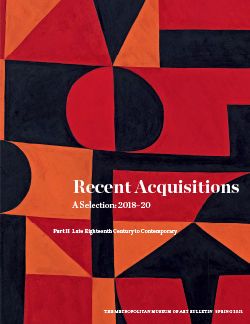Two horses
Charles Ray American
The monumental Two horses is the first work made by Ray in granite. The ambitious relief synthesizes many of the artist’s long-standing sculptural interests while taking as its subject an equine form that is replete with art historical references.
Ray’s work is deeply invested in exploring at multiple registers the intertwined relationship between time and sculpture. Gestating for several years, Two horses underwent a slow, painstaking process of drafting, testing and creating the image in different scales, and in a range of materials, with the artist eventually choosing a single specific block of black Virginia granite. Granite is an igneous rock formed by the slow cooling of molten magma, in the process creating interlocking crystals of feldspar, quartz, and mica which are apparent to the eye. For Ray, this intrinsic quality of granite—a geological manifestation of the coursing of time through matter—lends it ideally to the production of a sculpture that meditates on this very theme. The Latin granum or grain that gives the stone its name offers vivid evidence of this evolutionary process of deep-earth disruption and its petrification. The rock’s inherent horizontal striations, which when worked through the sculptural articulation allow the material to feature as part of the composition, create a visually active surface, pulsating with incipience.
Working with a master stone mason in Madison, Wisconsin, Ray initially had the work carved by a machine with a robotic arm and it was subsequently refined by human hand. The sculpture was modeled on a single horse which was then doubled, with the rear animal only partially visible. Close inspection of the work’s matte surface is intended to reveal traces of the process of the relief’s mechanical production. In this manner, the artist anachronistically combines cutting-edge technology with material originating at the birth of the planet, and by extension locates the period of human intervention and mortality in sobering, relative terms. As Ray has observed, "A sculpture physically ages as it slips into time. Authorship, context and content fade away long before sculptural stone turns into sand."[1]
Time also manifests in this relief through Ray’s drawing upon a range of works in the history of art. While the well-established Euro-American art historical trope of the equestrian monument is a clear allusion, the artist has also avidly studied the Assyrian reliefs, Etruscan objects, Greek and Roman vases and steles, and neo-classical American figurative sculptures at The Met, and references to such works are obliquely discernible in Two Horses. The passage of time in space, for instance, can be recognized in the staggered, spectral presence of the horse in duplicate, that with one hind hoof slightly raised evokes the 19th century serial photographic experiments of Eadweard Muybridge’s images of the horse’s animation arrested in motion. The doubled, shadowy ghost-like presence of the rear horse rendered in shallow relief is also reminiscent of the repetition of equine figures on Greek amphorae and kraters, while the layering of figures in relief recall a work like The Children of Jacob H. Schiff by Augustus Saint-Gaudens.
Ray’s preoccupation with doubling stretches back to earlier investigations into the figure of the mannequin as a sculptural proxy for the human being. The facsimiled figure in this work is seen simultaneously but with only partial presence, and is a strategy used by the artist to suggest temporal transition and its material translation in the same instant. The almost-twinned horse thus functions as both archetype and allegory, coalescing the ancient and the contemporary in one monumental work.
[1] Charles Ray and Massimiliano Gioni. "Charles Ray, A Geological Take on Time." Artpress, September 2018, p. 39.
This image cannot be enlarged, viewed at full screen, or downloaded.

